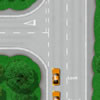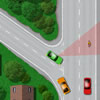A learner driver taking the UK driving test will of course be required to take many left and right turns. Some of these may be on busy high speed roads, whilst others on narrow, quiet residential streets.
Whilst making left or right turns, all road types harbour potential dangers and hazards. There is also a correct method that must be adhered to which the examiner will be expecting you to follow. This tutorial will explain this method for making left and right turns along with the potential hazards and dangers that all drivers, including learners should be aware of.
Learning left and right turns
Whilst learning to drive, practice as many different types of left and right turns as possible, as the driving test will involve many types. The various left and right turns practiced can be from quiet residential streets that often hide hazards such as pedestrians, cyclists and parked cars making it difficult to manoeuvre around.
During the test, turns may also include rural country roads and exiting a dual carriageway, all of which use the same technique but come with their own particular hazards.
The driving examiner will also expect you to make left and right turns onto high speed 50 or 60 mph national speed limit roads. These types of roads can be difficult to judge the speed of approaching vehicles and will require plenty of practice.
Where to practice left and right turns
Often practice will start on quiet residential streets with little traffic. Practice in these quiet areas and also use this time to practice passing parked cars. As you gradually gain in confidence, start to involve busier town and city roads and also country roads.
Once a learner has gained proficiency, browse the driving test routes that are applicable to your driving test centre. Although test routes are subject to change and may not be identical to the routes taken during your driving test, they will provide you with knowledge of the types of roads that are likely to be taken during your driving test.
Left and right turns tutorials
Below is the correct method for taking left and right turns and should be applied during the practical driving test.

How to make a left turn
Entering junctions (such as left turns) and exiting junctions is covered to a large extent during the driving test. This tutorial explains the correct procedure for making left turns along with typical UK road signs that you will likely encounter. The left turn tutorial also explains the common hazards often met by drivers whilst making a left turn, such as pedestrians and cyclists.

How to make a right turn
Making right turns often fills a learner driver with dread as they have to give way to oncoming traffic. During a driving test, the examiner often requests that a learner turns right to cross the path of a busy road so as to establish the learner can judge traffic speed correctly. This tutorial explain the correct technique for making right turns, along with road sighs and potential hazards often met by drivers.

Y-Junctions
Y-junctions are essentially left and right turns, with the minor road being at an acute angle. Y-junctions represent their own challenges which is explained in this tutorial.
